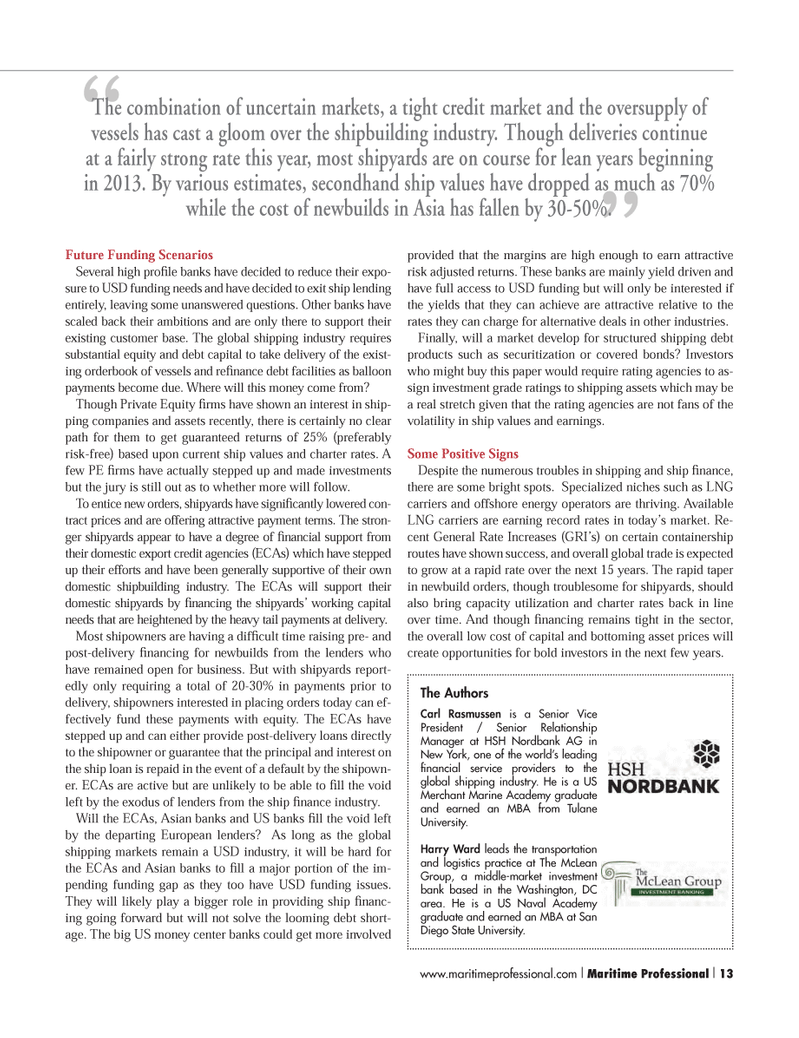
Page 13: of Maritime Logistics Professional Magazine (Q3 2012)
Classification Societies, Quality & Design
Read this page in Pdf, Flash or Html5 edition of Q3 2012 Maritime Logistics Professional Magazine
Future Funding Scenarios Several high proÞ le banks have decided to reduce their expo- sure to USD funding needs and have decided to exit ship lending entirely, leaving some unanswered questions. Other banks have scaled back their ambitions and are only there to support their existing customer base. The global shipping industry requires substantial equity and debt capital to take delivery of the exist- ing orderbook of vessels and reÞ nance debt facilities as balloon payments become due. Where will this money come from? Though Private Equity Þ rms have shown an interest in ship- ping companies and assets recently, there is certainly no clear path for them to get guaranteed returns of 25% (preferably risk-free) based upon current ship values and charter rates. A few PE Þ rms have actually stepped up and made investments but the jury is still out as to whether more will follow. To entice new orders, shipyards have signiÞ cantly lowered con- tract prices and are offering attractive payment terms. The stron- ger shipyards appear to have a degree of Þ nancial support from their domestic export credit agencies (ECAs) which have stepped up their efforts and have been generally supportive of their own domestic shipbuilding industry. The ECAs will support their domestic shipyards by Þ nancing the shipyardsÕ working capital needs that are heightened by the heavy tail payments at delivery. Most shipowners are having a difÞ cult time raising pre- and post-delivery Þ nancing for newbuilds from the lenders who have remained open for business. But with shipyards report- edly only requiring a total of 20-30% in payments prior to delivery, shipowners interested in placing orders today can ef- fectively fund these payments with equity. The ECAs have stepped up and can either provide post-delivery loans directly to the shipowner or guarantee that the principal and interest on the ship loan is repaid in the event of a default by the shipown- er. ECAs are active but are unlikely to be able to Þ ll the void left by the exodus of lenders from the ship Þ nance industry. Will the ECAs, Asian banks and US banks Þ ll the void left by the departing European lenders? As long as the global shipping markets remain a USD industry, it will be hard for the ECAs and Asian banks to Þ ll a major portion of the im- pending funding gap as they too have USD funding issues. They will likely play a bigger role in providing ship Þ nanc-ing going forward but will not solve the looming debt short- age. The big US money center banks could get more involved provided that the margins are high enough to earn attractive risk adjusted returns. These banks are mainly yield driven and have full access to USD funding but will only be interested if the yields that they can achieve are attractive relative to the rates they can charge for alternative deals in other industries. Finally, will a market develop for structured shipping debt products such as securitization or covered bonds? Investors who might buy this paper would require rating agencies to as- sign investment grade ratings to shipping assets which may be a real stretch given that the rating agencies are not fans of the volatility in ship values and earnings. Some Positive Signs Despite the numerous troubles in shipping and ship Þ nance, there are some bright spots. Specialized niches such as LNG carriers and offshore energy operators are thriving. Available LNG carriers are earning record rates in todayÕs market. Re- cent General Rate Increases (GRIÕs) on certain containership routes have shown success, and overall global trade is expected to grow at a rapid rate over the next 15 years. The rapid taper in newbuild orders, though troublesome for shipyards, should also bring capacity utilization and charter rates back in line over time. And though Þ nancing remains tight in the sector, the overall low cost of capital and bottoming asset prices will create opportunities for bold investors in the next few years. ??The combination of uncertain markets, a tight credit market and the oversupply of vessels has cast a gloom over the shipbuilding industry. Though deliveries continue at a fairly strong rate this year, most shipyards are on course for lean years beginning in 2013. By various estimates, secondhand ship values have dropped as much as 70% while the cost of newbuilds in Asia has fallen by 30-50%. The Authors Carl Rasmussen is a Senior Vice President / Senior Relationship Manager at HSH Nordbank AG in New York, one of the world?s leading nancial service providers to the global shipping industry. He is a US Merchant Marine Academy graduate and earned an MBA from Tulane University. Harry Ward leads the transportation and logistics practice at The McLean Group, a middle-market investment bank based in the Washington, DC area. He is a US Naval Academy graduate and earned an MBA at San Diego State University. www.maritimeprofessional.com I Maritime Professional I 13MP #3 1-17.indd 13MP #3 1-17.indd 138/14/2012 5:12:37 PM8/14/2012 5:12:37 PM

 12
12

 14
14
